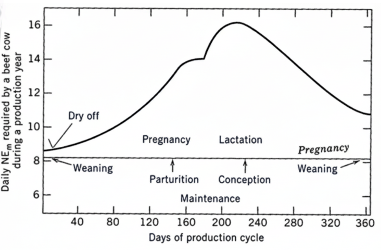Cow-Calf Commentary for Iowa Cattleman Magazine
By Randie Culbertson, Cow-Calf Extension Specialist
December 2025
Keep it simple - Winter Cow Feeding
Years ago, a wise cattleman once told me when it came to feeding cows to “keep it simple, stupid.” The concept of “keep it simple, stupid” often refers to a principle that advices against unnecessary complexity and advocating for simplicity in systems to make them more effective and user-friendly. When it comes to nutrition, you cannot ignore it. Providing adequate nutrition for your cow herd is critical for animal performance, but it also can become your largest operational cost. When feeding cows through the winter, some basic principles should be considered and the concept of keeping it simple can be applied to get the most bang for your buck.
- Stage of production - Understanding where the cow is in her production cycle can help you manage your feeding program. During early pregnancy, the nutritional requirements are fairly low but as the fetus grows the nutritional demand also increases. Weaning is considered her lowest nutrient/metabolic requirement while peak lactation would be her highest. Other considerations are the cow’s level of milk production and mature size. Both affect the amount of groceries she would needed to maintain body condition.

Figure 1. Representation of net energy requirements for a typical beef cow during a production year (adapted from Basic Animal Nutrition and Feeding). - Meeting nutritional requirements – This should be a priority when feeding a cow herd. Successful feeding programs require that nutritional requirements are met. As she progresses towards calving, her protein and energy requirements will increase. For fall calving herds, these cows will be hitting peak lactation. Knowing where she is in her production cycle can help you determine what she needs, what she might be lacking. Depending on what you are feeding, you may need to supplement to meet requirements. Table 1 breaks down what and when you would need to consider supplementing protein (CP), energy (TDN), or if no supplementation is typically needed. The table makes multiple assumptions and knowledge of how these feeds were put up, growing season impacts, and if they are above, at or below average quality is essential. Lastly, don’t forget those vitamins and minerals! Offering mineral free-choice in weather-protected feeders and ensuring consistent access throughout the year helps prevent deficiencies and maintains overall herd health. To develop a more detailed ration for your cow herd, software programs such as BRaNDS are available to help.

Table developed by Beth Reynolds and Erika Lundy-Woolfolk and adapted from NRC, 2000 and NASEM, 2017. - What’s on the menu – Not all feedstuffs are created equally. This also applies for feeding hay. Do you know the quality of the hay you are feeding? Your cows may have plenty of hay in front of them, but if the hay is poor quality, they are basically ingesting empty calories and it may not be doing them much good. This year’s rain wreaked havoc on our ability to put up hay in ideal conditions, and while the yield boosts were appreciated, rapid growth can adversely affect nutrient quality. Get your hay tested so you can plan accordingly for the winter and supplement if necessary. Multiple extension publications explain good sampling procedures, and many county offices even have a hay probe available for area producers. The National Forage Testing Association maintains a list of certified laboratories and resources as well.
- Manage feed waste - Key strategies for minimizing feed waste includes proper storage, delivery, and bunk management. Using well-designed bale feeders with rings around the bottom, reducing the amount of hay unrolled at one time, and feeding on frozen ground or in designated sacrifice areas can significantly limit trampling losses. Storing bales off the ground, covering them when possible, and placing them in well-drained locations also helps preserve forage quality. Together, these practices ensure cows receive consistent nutrition while reducing unnecessary feed loss and improving overall feeding efficiency. More tips to manage feed waste.
At the end of the day, you cannot ignore nutrition and providing adequate nutrition for your cow herd is critical. When it comes to feeding cows during the winter, focus on the management aspect and the big picture. As always, the Iowa Beef Center team is available to answer winter cow feeding questions.
2025 Archives
2024 Archives
